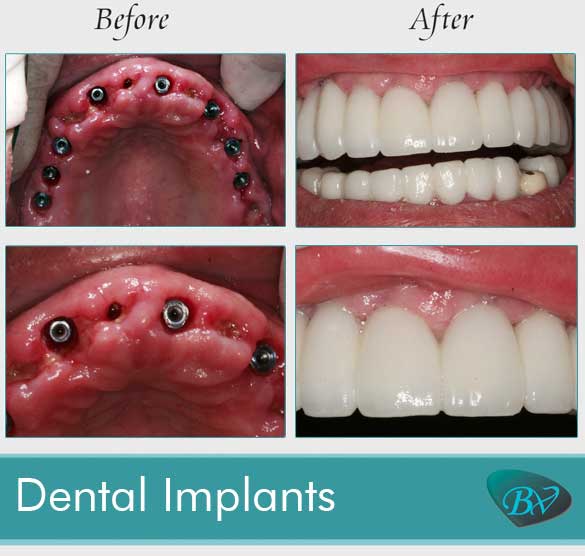Get This Report on Dental Sense
Get This Report on Dental Sense
Blog Article
Facts About Dental Sense Uncovered
Table of ContentsThe Main Principles Of Dental Sense Some Of Dental SenseOur Dental Sense StatementsThe Greatest Guide To Dental Sense
are medical devices surgically implanted into the jaw to restore an individual's capability to chew or their look. They give assistance for man-made (fake) teeth, such as crowns, bridges, or dentures. When a tooth is shed because of injury or illness, a person can experience difficulties such as fast bone loss, malfunctioning speech, or adjustments to eating patterns that lead to pain.Oral implant systems contain a dental implant body and dental implant joint and may additionally include an abutment addiction screw. Wisdom tooth cavity. The dental implant body is operatively inserted in the jawbone instead of the tooth's root. The oral implant abutment is normally affixed to the dental implant body by the abutment addiction screw and expands through gum tissues right into the mouth to support the affixed man-made teeth
(https://www.pubpub.org/user/matthew-music)Structure of The Dental Implant System picking oral implants, speak to your dental service provider about the possible advantages and dangers, and whether you are a candidate for the treatment. Points to think about: Your general health is an important consider establishing whether you are an excellent candidate for dental implants, the length of time it will certainly take to heal, and for how long the implant might remain in area.
Smoking may affect the healing process and lower the long-lasting success of the implant. The healing procedure for the dental implant body might take numerous months or longer, during which time you generally have a temporary abutment instead of the tooth. the dental implant procedure: Very carefully follow the dental hygiene guidelines given to you by your oral supplier.
Some Ideas on Dental Sense You Need To Know
Implant failing can result in the demand for another surgery to deal with or replace the implant system. Restores the capability to eat Recovers cosmetic appearance Assists keep the jawbone from shrinking due to bone loss Protects the wellness of the bordering bone and gums Helps keep surrounding (nearby) teeth steady Boosts lifestyle Damage to bordering all-natural teeth during implant placement Injury to the surrounding tissues during surgical treatment, such as sinus opening Injury throughout surgical procedure (as an example, fracture of bordering jawbone) Poor feature, such as feeling like the teeth do not bite together usually An experience that the tooth is loosened or turning in area arising from a joint screw loosening up Implant body failure (looseness of the implant body) due to systemic infection, which may be most likely in patients with uncontrolled diabetes due to regional infection in bone and gums supporting the implant body because of postponed recovery, which may be more probable in individuals that smoke Trouble cleaning the gums around the dental implant, leading to bad oral health Unattended gum illness Post-surgical numbness as a result of nerve impingement or damages Constantly alert wellness care suppliers and imaging service technicians that you have dental implants prior to any type of magnetic resonance imaging (MRI) or x-ray look at here now treatments.
FDA is not conscious of any type of adverse occasions reported for MRI or x-ray procedures with oral implants. Oral implants systems are normally made of products that adhere to global consensus requirements of the International Company for Standardization (ISO) or ASTM International. These criteria have details of what makes a secure product.

An oral implant is a framework that replaces a missing out on tooth. With screw-like devices, the doctor inserts a dental implant right into the jawbone, and it functions as a support for a man-made tooth, called a crown. A tool called a joint attaches the synthetic tooth to the dental implant. The crown is customized to fit the individual's mouth and match the shade of their teeth.
A Biased View of Dental Sense
Some people are not qualified for dental implant surgical procedure. It is for oral doctors to operate on individuals with: severe illnessuncontrollable metabolic diseasebone or soft tissue condition or infectionIf these concerns are settled, a person can have the surgery. In, oral doctors avoid from operating people with: If individuals with any of the above go through dental implant surgery, there is a greater danger of the dental implant stopping working.

Oral implant surgery is an individualized procedure. It's not the very same for every person. But the following offers a basic review of what you can anticipate your dentist, oral specialist, periodontist or prosthodontist to do: Put the implant surgically. Provide you time to heal. Attach the message and final crown, bridge or denture.
Next, your surgeon will thoroughly place the oral implant right into your jaw. Your surgeon will certainly rearrange your periodontals and close the laceration with stitches. If your dental implant is near the front of your mouth, your dental professional will make a temporary tooth for you to put on up until you heal. That means, you will not have a gap in your smile while you recover.
Indicators on Dental Sense You Need To Know
During the recovery stage, your jawbone should fuse to the dental implant. This process can take anywhere from 3 to 9 months.
When your dental implant heals, your dentist can affix the abutment (small port article) and your last restoration (crown, bridge or denture). This typically takes regarding one hour to finish and might require a second minor surgical treatment. You should not really feel any kind of discomfort during your dental implant procedure since your copyright will certainly use medicine to numb your periodontals.
Report this page